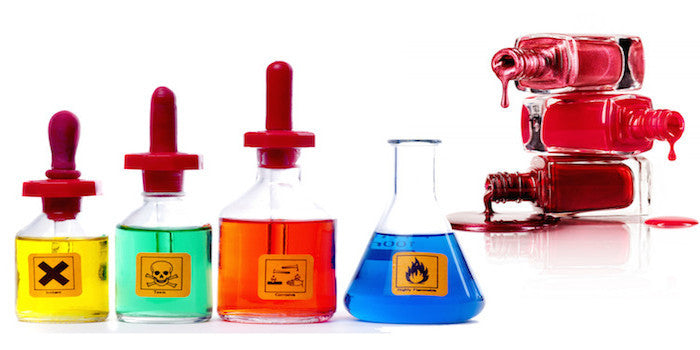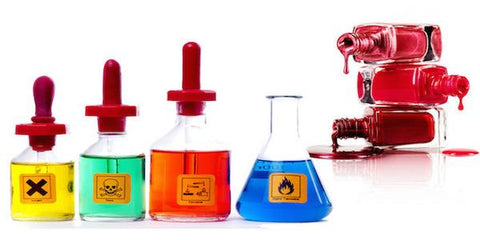
How to tell if there is formaldehyde in your beauty products?
Throughout the course of my career, in nutrition and skin care, I have never recommended a client of mine to “apply more formaldehyde” to assist in the process of anti-aging. Given the widespread use of formaldehyde as a preservative in cosmetics products, that is fundamentally what you risk every time you put your favorite facial moisturizer or under eye serum on your skin. I am sure that everyone, regardless of their educational background, knows that it is obviously unhealthy to expose yourself to formaldehyde. Strangely, the mass producers of common anti-aging and other personal care products have no issue with exposing millions of their customers to formaldehyde, despite common knowledge telling us it is harmful.
At this moment, you may be thinking to yourself, “I have read the ingredient labels on my skin care products and I do not see formaldehyde listed on the label, so my products must not contain any formaldehyde.” Companies know that formaldehyde has a stigma associated with it. This stigma stems mainly from its use in preserving dead bodies and as one of the more harmful ingredients in cigarette smoke. These companies also know that formaldehyde is a cheap and effective preservative. Mass producers of personal care products opt out of using liquid preparations of formaldehyde; commonplace in the personal care industry today is to use a class of chemicals that slowly release formaldehyde over time as they degrade. This group of chemicals is known as Formaldehyde Releasers (or formaldehyde donors).
The most commonly used Formaldehyde Releasers in the personal care industry today are:
- Quaternium-15
- DMDM Hydantoin
- Bronopol
- Imidazolidinyl
- Urea
- Diazolidinyl Urea
If your product contains one or more of these chemicals, unfortunately for you, that product definitely will contain formaldehyde.
Below is an ingredient list from mass produced Micro-Sculpting Serum that contains a formaldehyde releaser and is commonly sold in department stores:
Water, Cyclopentasiloxane, Glycerin, Niacinamide, Aluminum Starch Octenylsuccinate, Dimethicone, Panthenol, Dimethicone Crosspolymer, Polyethylene, Palmitoyl Pentapeptide-4, Sodium Hyaluronate, Camellia Sinensis Leaf Extract, Tocopheryl Acetate, Carnosine, Allantoin, Dimethiconol, Polyacrylamide, C13-14 Isoparaffin, Laureth-4, Laureth-7, Citric Acid, Peg-100 Stearate, DMDM Hydantoin, Bht, Disodium Edta, Tin Oxide, Fragrance, Iodopropynyl Butylcarbamate, Titanium Dioxide, Mica
This product also contains "Fragrance", another harmful ingredient that commonly is used in cosmetic products.

LEARN HOW TO READ COSMETIC LABELS
The FDA requires no such labeling in the United States...
In its normal state formaldehyde is a highly toxic gas; it is nearly colorless, flammable at room temperature, and has a very strong odor (capable of causing irritation at concentrations below 1ppm). Pure formaldehyde gas has a tendency to polymerize, so it is commonly used and stored in a solution (of formaldehyde, water, and methanol) known as Formalin. Many other countries have limited or banned its use in certain products, yet the FDA has done nothing to impose limits on the use of formaldehyde in personal care products and protect people of the United States from its harmful and carcinogenic effects. Both Japan and Sweden have banned its use in cosmetics and toiletries.(1) The European Union (EU) and Canada have placed restrictions on the concentrations allowed in cosmetics and other personal care products.(2) The EU’s guidelines only allow a maximum concentration of 0.2% or 200ppm (parts per million) of formaldehyde in finished products. Also, the EU requires that any finished products containing formaldehyde or chemicals that release formaldehyde must have a warning label stating ‘contains formaldehyde’ if the concentration of free formaldehyde in the finished product exceeds 0.05% or 500ppm.(1) The FDA requires no such labeling in the United States, so the average consumer is totally unaware that so many of their products contain a formaldehyde releasing substance.
It is true that cosmetics and other personal care products deliver a lower dose in the spectrum of possible sources of formaldehyde exposure. However, it must be acknowledged that the average person has multiple products they use on a daily basis that contain formaldehyde via formaldehyde releasers. This makes it extremely difficult to determine the actual dose of formaldehyde the average person is routinely exposing himself or herself to. It is quite likely that your body wash, face wash, shampoo, conditioner, moisturizer, and any other skin care products you use contain some form of formaldehyde-releasing chemical. According to FDA data, over 1 in 5 cosmetic products produced contains a formaldehyde-releasing chemical.(4)

Why is formaldehyde so dangerous in your beauty products?
The main concern regarding the use of formaldehyde releasers in cosmetics is not the immediate side effects of irritation to the skin. What we are truly worried about is the potential for them to cause cancer. Formaldehyde is classified as a known human carcinogen by the International Agency for Research on Cancer and the National Toxicology Program recognizes formaldehyde as a probable human carcinogen.(5) The National Toxicology Program’s June report classified formaldehyde as a carcinogen under conditions with high, or prolonged, exposure.(6) Using cosmetics with formaldehyde releasers is clearly repeated low-dose exposure to formaldehyde through your skin. We know that frequent inhalation exposure of formaldehyde at low doses is extremely toxic.
In a 2004 study done by the North American Contact Dermatitis Group, the following results were found:
- Quaternium-15: caused an allergic reaction in 9.3% of patch test patients.
- DMDM Hydantoin: caused an allergic reaction in 2.8% of patch test patients.
- Imidazolidnyl Urea: caused an allergic reaction in 3.0% of patch test patients.
- Bronopol: caused an allergic reaction in 3.3% of patch test patients.
- Formaldehyde: released by these chemicals caused an allergic reaction in 8.4% of patch test patients.(3)
The main concern regarding the use of formaldehyde releasers in cosmetics is not the immediate side effects of irritation to the skin. What we are truly worried about is the potential for them to cause cancer. Formaldehyde is classified as a known human carcinogen by the International Agency for Research on Cancer and the National Toxicology Program recognizes formaldehyde as a probable human carcinogen.(5) The National Toxicology Program’s June report classified formaldehyde as a carcinogen under conditions with high, or prolonged, exposure.(6) Using cosmetics with formaldehyde releasers is clearly repeated low-dose exposure to formaldehyde through your skin. We know that frequent inhalation exposure of formaldehyde at low doses is extremely toxic.
Occupational Safety and Health Administration, commonly referred to as OSHA, has very strict guidelines on what are acceptable levels of inhalation exposure to formaldehyde in the workplace:
- OSHAPEL (permissible exposure limit) = 0.75 ppm (averaged over an 8-hour work shift)
- OSHASTEL (short-term exposure limit) = 2 ppm (15) minute exposure) (7)
The National Institute for Occupational Safety and Health, or NIOSH, guidelines for Formaldehyde exposure are:
- NIOSH IDLH (immediately dangerous to life or health) = 20 ppm (7)
These health and safety organizations have clearly taken the dangers of formaldehyde exposure seriously and take action to ensure that workers are not exposed to dangerous levels of the substance in industrial environments. With the evidence plainly showing the carcinogenic effects of formaldehyde, why does the FDA refrain from imposing restrictions on its use? According to EWG senior scientist David Andrews, Ph.D., “Formaldehyde is a case study in EPA paralysis. Despite being widely acknowledged as causing cancer, political meddling and endless review have stalled agency efforts to reduce consumer and worker exposures. In 2008, the Government Accountability Office highlighted formaldehyde as one of three pressing examples of political interference hindering the Agency’s efforts to “complete timely, credible assessments” for hazardous chemicals. Further delays in EPA’s formaldehyde assessment mean more risk to consumers, and more cancer.”(8)
Where to buy chemical free skin care products?
There is no need for companies to be using formaldehyde releasers as preservatives in this day and age. Stacy Malkan, a co-founder of the Campaign for Safe Cosmetics, asserts that, “There's no acceptable level of formaldehyde in products. Alternatives are readily available, so there's no reason to be exposing anybody to a known carcinogen.”(9) We need to actively avoid any extra exposure sources of formaldehyde in our lives. Take the extra few minutes to read the labels on the personal care products you are considering purchasing. If they contain any of the aforementioned formaldehyde-releasing chemicals, DO NOT BUY THEM! Remember, your dollar is your vote. What you put on your skin DOES matter. Chemicals age you faster. Here, at AMG Naturally, we believe in products that only contain natural ingredients and natural preservatives. We proactively choose to say no to harmful preservatives like formaldehyde in all of our products. Our advanced skin care products are Naturally Green & Naturally Clean, helping you to Age More Gracefully, (AMG).
References:
(1) Scientific Committee on Cosmetic Products and Non-food Products. Opinion concerning a clarification on the formaldehyde and para-formaldehyde entry in Directive 76/768/EEC on cosmetic products. Opinion: European Commission. 2002. Available at http://ec.europa.eu/food/fs/sc/sccp/out187_en.pdf. Accessed October 16, 2009.
(2) Other uses of formaldehyde have different restrictions in Canada. For example, nail hardeners may contain concentrations equal to or less than 5% and oral care products may contain concentrations equal to or less than 0.1%. Formaldehyde is not permitted in aerosol cosmetics. See Canada’s Cosmetic Ingredient Hotlist, March 2007. www.hc-sc.gc.ca/cps-spc/person/cosmet/info-ind-prof/_hot-list-critique/hotlist-liste_1-eng.php. Accessed October 16, 2009.
(3) Pratt, M.D., Belsito, D.V., DeLeo, V.A., Fowler, J.F., Jr., Fransway, A.F., Maibach, H.I., et al. (2004). North American contact dermatitis group patch-text results, 2001-2002 study period. Dermatitis, 15, 176-183.
(4) Congleton, Johanna. "Is Cancer-causing Formaldehyde in Your Cosmetics?" Environmental Working Group. EWG, 1 Dec. 2013. Web. 10 Dec. 2014. <http://www.ewg.org/research/exposing-cosmetics-cover/formaldehyde-releasers>.
(5) International Agency for Research on Cancer. “IARC classifies formaldehyde as carcinogenic to humans.” Press release. June 15, 2004. www.iarc.fr/en/Media-Centre/IARC-Press-Releases/Archives-2006-2004/2004/IARC-classifies-formaldehyde-as-carcinogenic-to-humans. Accessed January 9, 2009.
(6) U.S. Department of Health and Human Services, Public Health Service, National Toxicology Program. ”Formaldehyde (Gas) CAS No. 50-00-0: Reasonably anticipated to be a human carcinogen.” Eleventh Report on Carcinogens. December 2002. Available at: http://ntp.niehs.nih.gov/ntp/roc/eleventh/profiles/s089form.pdf. Accessed October 16, 2009.
(7) "Formaldehyde (HCHO)." Formaldehyde General Information. Web. 12 Dec. 2014. <http://www2.udec.cl/matpel/hazardous_materials/formaldehyde.pdf>.
(8) "National Academy of Sciences: Formaldehyde Causes Cancer." Environmental Working Group. EWG, 8 Apr. 2011. Web. 12 Dec. 2014. <http://www.ewg.org/news/news-releases/2011/04/08/national-academy-sciences-formaldehyde-causes-cancer>.
(9) Meijia, Lisette. "Formaldehyde in Cosmetics: What's the Verdict?" Womenshealthmag.com. Women's Health, 4 Oct. 2011. Web. 10 Dec. 2014. <http://www.womenshealthmag.com/style/safe-cosmetics>.


